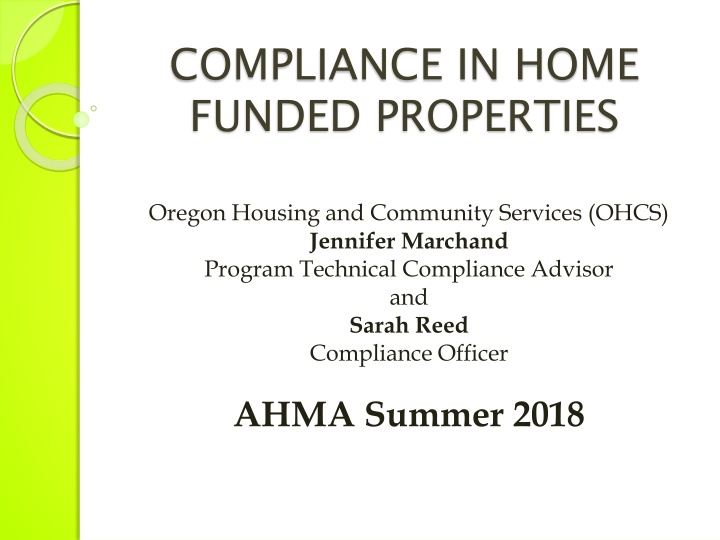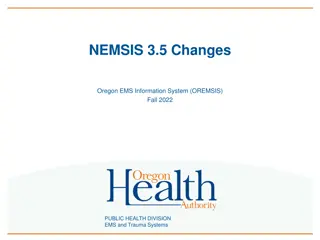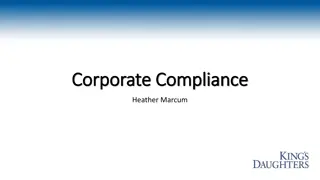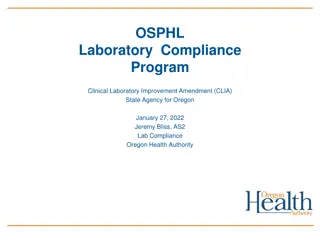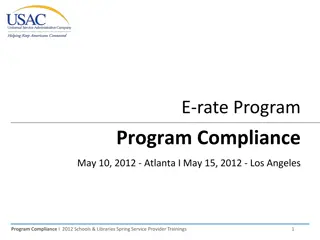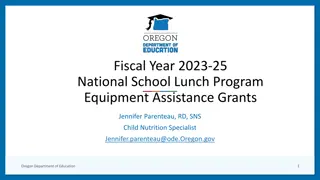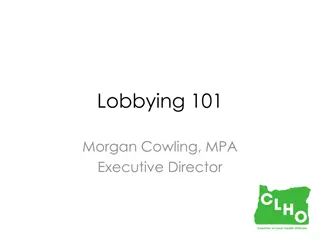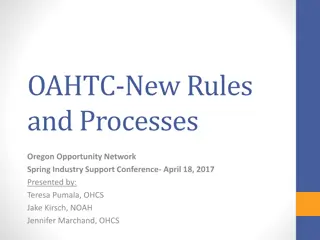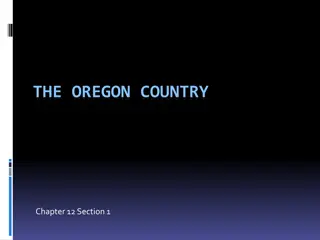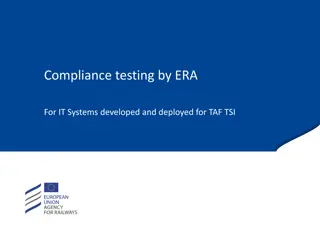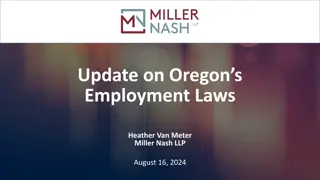HOME Program Compliance in Oregon
Explore the intricacies of the HOME program compliance in Oregon presented by Oregon Housing and Community Services team, covering topics such as HOME program overview, allocation, Participating Jurisdictions (PJs), and more.
Download Presentation

Please find below an Image/Link to download the presentation.
The content on the website is provided AS IS for your information and personal use only. It may not be sold, licensed, or shared on other websites without obtaining consent from the author.If you encounter any issues during the download, it is possible that the publisher has removed the file from their server.
You are allowed to download the files provided on this website for personal or commercial use, subject to the condition that they are used lawfully. All files are the property of their respective owners.
The content on the website is provided AS IS for your information and personal use only. It may not be sold, licensed, or shared on other websites without obtaining consent from the author.
E N D
Presentation Transcript
COMPLIANCE IN HOME FUNDED PROPERTIES Oregon Housing and Community Services (OHCS) Jennifer Marchand Program Technical Compliance Advisor and Sarah Reed Compliance Officer AHMA Summer 2018
Agenda for the Day Welcome and Introductions What is HOME? HOME Compliance (The 4 R s) Noncompliance Adding in LIHTC (the 5thR)
Purpose and Disclaimer To provide information on the HOME program and State of Oregon (OHCS) expectations for compliance. *Disclaimer: This presentation has not been reviewed by HUD and should not be cited or relied upon for interpretation of federal regulations or legal opinion.
HOME Program Overview What is the HOME Investment Partnerships Program (aka HOME program)? HOME is the largest Federal block grant allocated to state and local governments by HUD designed exclusively to create affordable housing for low and very low income households.
How is HOME Allocated? HUD provides formula grants to States and localities that communities use - often in partnership with local nonprofit groups - to fund a wide range of activities including: Building, buying, and/or rehabilitating affordable housing for rental purposes or homeownership or providing direct rental assistance in the form of a subsidy to low-income people (aka TBRA)
What is a HOME PJ? A Participating Jurisdiction (PJ) is responsible for ensuring that all HOME funds received and subsequently allocated from HUD are used in accordance with the HUD Federal requirements, regardless of whether funds are actually administered by sub recipients, state recipients, or contractors. Every PJ is monitored by HUD CPD (Community Planning and Development).
PJs in Oregon State of Oregon (OHCS) City of Corvallis City of Eugene-Lane County City of Portland (PHB)- City of Gresham City of Salem Clackamas County Washington County
Staying Right with Compliance It is as simple as this! Just practice the four R s! The Right People in the Right Unit at the Right Price for the Right Period of time!
Right People Who are the Right People? How Do I find them? The Right People: Tenant Selection and Marketing Tenant Application Applicant Rejection Tenant Wait List Tenant Interviewing Tenant Qualification
Affirmative Fair Housing Marketing Affirmative marketing procedures must be adopted for rental properties containing five or more HOME assisted housing units. AFHMP s are approved at development and transferred to the Asset Management Section for compliance with the loan file Plans must be updated at least every five years and submitted to OHCS for review and approval The Equal Housing Opportunity slogan, logo, or statement must be used on all materials The HUD Fair Housing poster must be displayed A copy of the AFHMP and Management plan with attachments should be retained on site for reference
Affirmative Marketing Maintain a file of Marketing Efforts Newspaper Clips Craigslist print-outs Flyers For Rent Magazine Advertisements Social Service Contacts Photos of signs etc. *Using the internet as the only source of marketing is not allowed as some people do not have access to the internet Does your marketing mirror your plan?
Tenant Selection Every Property Must Have a Written Tenant Selection plan. This plan must be current at all times and updated on a regular basis. The plan should be specific to the property and not the Management Company s practices. To create the plan you must identify the criteria that will be used to select tenants including how you will re-designate HOME assistance if necessary. Information in the plan must be objective and applied consistently Indicate how you will evaluate the tenant s ability to pay rent Indicate how you will screen for credit, previous rental, and criminal history Describe HOME requirements Identify income limits and rents and verification process Identify established occupancy limits Identify recertification requirements
Tenant Selection Plan Describe how vacant units will be filled *Such as chronological order of application Describe how lower set-aside units will be rented or swapped when they become available either due to vacancy or the current tenant going over income When considering the marketing requirements of accessible units you must offer the accessible unit to: 1stExisting residents 2ndWaiting list 3rdAdvertise features 4thNext on waiting list
Tenant Selection Plan Other Information to Include in the Plan: Eligibility under the Student Rule Policy for Unit Transfers (for HOME must requalify) Requests from Residents Requirement by Owner Acceptable Reasons for Transfers (must requalify) Placement on Transfer Waiting List (must requalify) Procedure for placing applicants on multiple lists Procedure for removing applicants from list Procedure for weeding of list Procedure for applying preferences if applicable
Tenant Selection Procedures to Determine an Applicant s History Past Performance Record of Disturbance Involvement in Criminal Activity Record of Eviction Complying with the Lease Misrepresentation of Information Review of Information Screening for Credit History Screening for Rental History Screening for Housekeeping Habits Denial for Drug Abuse and Other Criminal Activity Screening for Other Criminal Activity Violence Against Women Act (VAWA) The Home Visit if applicable
Tenant Selection Make sure that you include information on rejection of ineligible applicants and your policies and procedures. Reasons for Rejection should include: Reasons why an applicant may fail the Screening Criteria How an applicant will be notified that they are rejected Appeal Process
Tenant Selection Plan Other Information to Include in the Plan: Fair Housing and Equal Opportunity Requirements Non-Discrimination Information Section 504 of the Rehabilitation Act of 1973 Reasonable Modifications Reasonable Accommodations Information Regarding Handicaps Auxiliary Aids to Ensure Effective Communication Assistance Animals Accessible Route Equal Access The plan must be Non-bias and non-discriminatory The plan must include acceptable Fair Housing language taking into consideration the specific National, State, and local protections that exist for the applicants.
Tenant Selection Protections Federally Protected Classes: race color national origin religion gender familial status disability State Protected Classes Include: marital status source of income sexual orientation including gender identity domestic violence victims Examples of local protections: type of occupation ethnicity ancestry http://www.fhco.org/information-for-housing-providers
Tenant Application Written Application Must Include at a Minimum: Name & birth date for each occupant Social Security number for each occupant All sources & amounts of annual income Previous rental history Signature & date of applicants Date & signature of management upon acceptance of application Student Status Question regarding expected changes to household in next 12 mos.
Applicant Rejection What you need to know: Applicants who are denied must receive proper notice of denial explaining reason for denial in writing Appeal process must be communicated Documentation must be kept on file for review The application along with the denial notice must be kept and made available to OHCS, HUD, or Fair Housing when requested
Waiting List A waiting list must be established and maintained so that OHCS, HUD and FHCO can follow the progression of applicant placement. What you need to know: Format should be written Applicants should receive notification in writing of eligible/ineligible status on wait list Notification should state the approximate time of unit availability Format must be in a form that can be audited Applicant must be offered the chance to accept or reject before offering to the next applicant Indicate your procedure for weeding/purging list and moving to next applicant *Purging the list on a regular basis is very IMPORTANT *Closing and Reopening the list requires permission and special action that must be followed
Tenant Interview Meeting with an applicant/tenant to clarify information in the application and explain the regulations and housing expectations is a good way to start a successful tenant and property management relationship. Take this as an opportunity to: Ask about discrepancies noted (for example hourly rate vs. gross ytd income) Review all documentation and compare information for completeness looking at the: Application Questionnaire Credit report Verifications Make sure to clarify corrections (have tenant sign) Do not use white out! Draw a line through the error and correct and initial Do not clarify eligibility situations (always re-verify) Tip: Any information obtained in a meeting with the tenant/applicant during the interview process should be clarified in writing and signed by both parties.
How to Qualify Tenants OHCS as well as all other Oregon HOME PJ s have adopted the HUD method of income calculation and verification as outlined in the HUD 4350 Guide as allowed and defined under 24 CFR 5.609. In addition an Owner/Agent should utilize the PJ s compliance manual as well as HUD guidebooks available on the web.
Tenant Qualification Tips for Qualifying Applicant Income: In general Owner/Agents must assume that today s circumstances will continue for the next 12 months unless there is verifiable evidence to the contrary. Anticipated Income must be verifiable (Job offer letter, etc.) Do not count phantom income ( I may get a job ) Known changes to income must be included in the income calculation (think minimum wage increase or COLA) Tip: Common income Surprises include Child support, Social Security, Veterans Assistance, Bonuses, Periodic Income and Tip income. Remember: Deductions cannot be deducted from gross income for child support or alimony, etc.
Tenant Qualification Income Tips Specific to Household Members: Head/Co-head and Spouse Include all earned, unearned, and asset income Minors Under Age 18 (including fosters) Exclude earned income Include unearned income (Social Security and child support, etc.) Students 18+ (not the head/co-head or spouse) Only include first $480 of earned income Include all unearned and asset income Temporarily Absent Household Member Include all earned, unearned, and asset income Permanently living in a hospital or nursing home Household must make the decision to include or not
Tenant Qualification Self Employment Income Calculate the Net Income from the Operation of a business or profession. Costs to expand a business or costs incurred with recapitalizing a business cannot be included as deductions. Any withdrawal of cash or assets from the operation of the business will be included in income unless the withdrawal is used to reimburse cash or assets that were in invested in the business by the family (essentially a loan). Annualize Self Employment based on tax return (must have all schedules attached as applicable) Make sure to include wages or contract labor that the business owner has paid himself or household members as applicable Double check the timeframe on the tax return! Does it represent a full year? When was the business started? You may need to adjust calculations to represent a full year. If the business has not been in operation long enough to file a tax return obtain financial statements, written statement from the business owner and a tax form completed with the appropriate schedule (such as Schedule C Profit and Loss) showing the current business status.
Tenant Qualification Self Employment Continued earning income from your own business or profession rather than by working for someone else who determines your wages Tips: Determine if the person is truly self employed If you cannot verify income you are not obligated to rent to the household Simple Google Searches will tell you a lot Bank Statements are excellent back-up Tax filing obligations are much more strict when compared to public perception.
Tenant Qualification Social Security and Other benefits The full amount of periodic amounts received from social security, pensions, retirement funds, disability, survivor benefits etc. must be counted. Tips: Count amount before Medicare is deducted Delayed SS, SSI, and VA payments are not counted Count amount after any applicable adjustment for past overpayments when looking at SS, SSI, VA, TANF and Unemployment Make sure to include COLA as applicable Make sure to know anticipated minimum wage increase
COLA & Minimum Wage Social Security COLA information is normally announced in October or November of each year. The 2018 increase of 2% was announced on 10-13-17 for 01-01- 2018 implementation. Oregon Minimum Wage Schedule for Standard Counties enacted in 2016 by Oregon Legislature Senate Bill 1532. January 1, 2016 $9.25 July 1, 2016 $9.75 July 1, 2017 $10.25 July 1, 2018 $10.75 July 1, 2019 $11.25 July 1, 2020 $12.00 July 1, 2021 $12.75 July 1, 2022 $13.50
Minimum Wage Continued It is important to know what County the employer is located in as there are three pay scales for minimum wage implementation. 1) Standard- 2018 Rate $10.75 2) Portland Metro (Urban Growth Boundary)- 2018 Rate $12.00 3) Non-Urban- 2018 Rate $10.50 The nonurban rate applies to employers located within the following counties: Baker, Klamath, Coos, Lake, Crook, Malheur, Curry, Morrow, Douglas, Sherman, Gilliam, Umatilla, Grant, Union, Harney, Wallowa, Jefferson, Wheeler https://www.oregon.gov/boli/WHD/OMW/Pages/Minimu m-Wage-Rate-Summary.aspx
Tenant Qualification Split Pensions Per change 2 and 3 of HUD 4350: When a pension is split due to a divorce or other court action you are only obligated to count the net payment received by the person. This applies to all Federal Government, State Government, Local Government, Social Security and other private pensions. Tip: May be disbursed in a one time lump sum.
Tenant Qualification Child Support and Alimony All child support or alimony awarded by the court must be included in income unless the applicant/tenant certifies that the payments are not being made and that all reasonable legal action has been taken to collect amounts due including filing with the appropriate court or agency in their area that is responsible for enforcing.
Tenant Qualification Tips for determining household size: Do not count the following household members when determining household size for the purpose of comparing annual income for the HOME program Live-in Aides Guests Unborn children Children being pursued for legal custody or adoption who are not currently living with the household Update: With Change 4 (HUD 4350.3) Foster Children and Adults are now counted as household members when determining household size for occupancy limits as well as income limits
Tenant Qualification Tips for determining Asset Income: All asset income must be third party verified and annualized Using the LIHTC Under $5000 Asset Certification form is not allowed for HOME assisted units Actual Income from an asset is the actual interest earned Imputed Income is the cash value x passbook rate *Passbook rate updated to 0.06% as of 2/1/2015 and no change as of yet If the cash value of combined household assets is $5,000.00 or greater the calculation for the asset income used for determining total household asset income must be the greater of the actual or imputed amount
Tenant Qualification Real Estate Must be calculated to determine 1) Asset Value and 2) Income Value Asset: All steps must be taken to convert the fair market value of the Real Estate asset to an accurate cash value Asset value: Deduct the unpaid balance on loans secured by the property and reasonable costs that would be incurred in selling the property (such as penalties and broker fees) from the fair market value. Tips: Avoid using Zillow Try and obtain an actual listing for the property Contact Listing agent regarding actual fees Make sure that you collect all needed documentation If someone indicates that the property is in their name but claims it is not theirs, you may need to count it anyway Average fee for commission is currently at 6% in Oregon
Tenant Qualification Real Estate Continued: When determining the annual income from a property that is being rented out Deduct the annual mortgage interest payments and other allowed expenses (such as taxes, insurance, maintenance and other items as allowed per the schedule E of the tax return) from the annual rental payments to determine the net income Tips: Obtain a copy of rental contract Obtain a copy of tax return and schedule E Ask all questions necessary to determine what to verify and calculate
Tenant Qualification Assets: Tips: If an asset is jointly owned it may be prorated however not all jointly owned accounts must be counted (such as survivorship reasons) Interest should be applied to the market value and not the cash value of the asset Always ask yourself Do they have access? Always take steps to convert to cash Savings accounts use current balance Checking accounts use average balance last 6 mos. Know if a Trust term is Revocable or Non- Revocable
Tenant Qualification Assets or Income? An asset should be calculated as either an asset or as income. Not both! Tips: Is the holder receiving periodic payments? The withdrawal of cash or assets from an investment received as periodic payments should be counted as income (not an asset). If the household has access and could cash out a lump sum but payments are not being taken, the annuity is an asset and must be converted to cash for proper asset calculation. This also applies to other similar situations such as IRA s. Something to think about- What is considered periodic?
Tenant Qualification Income and Asset Information Become familiar with the HUD 4350 and specific income and asset guidance including exclusions. When in doubt look it up!
Tenant Qualification Student Households The 2013 HOME Final Rule implemented a Student Rule. HUD has clarified that: Adopted HCV/Sec. 8 reg. at 24 CFR 5.612 Applies to All HOME properties, both existing and new Must be looked at for all income determinations or recertification's on or after August 23, 2013 In-place tenants are not grandfathered, and HUD has indicated that Owners/Agents must apply over-income rules as applicable* *Assistance cannot be prorated and tenants cannot be evicted, however they are not eligible for HOME assistance and all steps must be taken to keep the HOME assistance in compliance (for example floating the HOME)
Student Tenant Qualification Students under age 24 do not qualify as a low income household and are not eligible for HOME assistance unless they: Are a dependent of the HOME assisted household living with a parent. Are independent of parents, or have parents who are income eligible. Meet specific exceptions: veteran, married, has dependent child, or are disabled and was receiving Sec. 8 assistance as of 11/30/2005. No distinction for PT or FT Students. Applies to all students enrolled in an institution of higher learning.
Student Tenant Qualification Student Status and Independent Verification: To show that a Student is independent Owners/Agents must verify and document that: The student is not claimed on the parent s tax return They do not get financial help from parents They have established a separate residence for at least 12 mos. or they meet the US Dept. of Education definition of an independent student Are of legal contract age under State law
Tenant Qualification Student Status and Parent Eligibility: To show that the student s parents are income eligible, the parents must sign a declaration and certification of income and they must be below the current HUD Low Income limit (80%) If parents live in the U.S. use the low income limit for the county that the parents live in. If they live outside the U.S. use the low income limit for the county that the property is located in
Tenant Qualification Student Status Parent Eligibility Continued: If parents do not live together: 1) If divorced or separated obtain a declaration from both parents 2) If widowed or single obtain a declaration from the single parent 3) If one parent s location is not known obtain declaration from single parent with a clarification regarding missing parent s status indicating that financial assistance is not obtained from the missing parent. Tip: Obtain parent s tax return Note: If the parents refuse to sign the declaration of income and/or provide a statement regarding possible financial assistance that they may or may not provide to the student, the student must be determined to be ineligible for HOME assistance.
Right Unit Now that you know how to choose the right person, what you need to know is how to choose the right unit Occupancy Standards Unit funding (does household qualify) Management Units Transfers Fixed and Floating Maintaining Unit Mix Low and High HOME
Right Unit Occupancy Standards HOME does not establish specific Occupancy limits or standards. Standards should be outlined in the tenant selection policy as established by Owner/Mgmt. When establishing standards it is important that you make sure that the standards you set are in line with Fair Housing requirements or guidance, and that the standards you set meet fire code for that city or county. In addition every effort should be made to accommodate appropriate sized families for larger units (for example trying to avoid placement of a single person in a 3 bedroom unit that could be utilized by a larger family that may need it). Industry standard is typically 2 per bedroom and 1 in the living areas.
Right Unit Unit Funding When a property has mixed funding it is important to remember that all of the funding requirements and restrictions for the property must be met. When looking at specific units that may become available for rent it is important to know if: 1) Is the unit accessible? 2) Is the unit a HOME unit? 3) What other restrictions are on the unit from various other sources?
Right Unit Management Units: If an employee or on-site manager resides in a HOME assisted unit the household must income qualify and otherwise qualify for HOME assistance. Tip: Income qualified Manager must be certified as low income tenant.
Right Unit Transfers Transfers are not allowed to other HOME Assisted units When a household is moved to a HOME assisted unit, you must complete a new HOME TIC and lease using move-in requirements. Third party verification and source documentation must be obtained. The household must qualify for HOME assistance. *This also applies when you are re-assigning HOME assistance to a new unit/household.
Right Unit Fixed and Floating Units Fixed Units always stay the same Floating Units = HOME Assistance can float to other units that are comparable in size and amenities Check the HOME grant agreement for information on your property Do NOT switch back and forth (the units are either fixed or floating) Have a documented method to maintain the unit mix Know for sure if the units are Fixed or Floating
